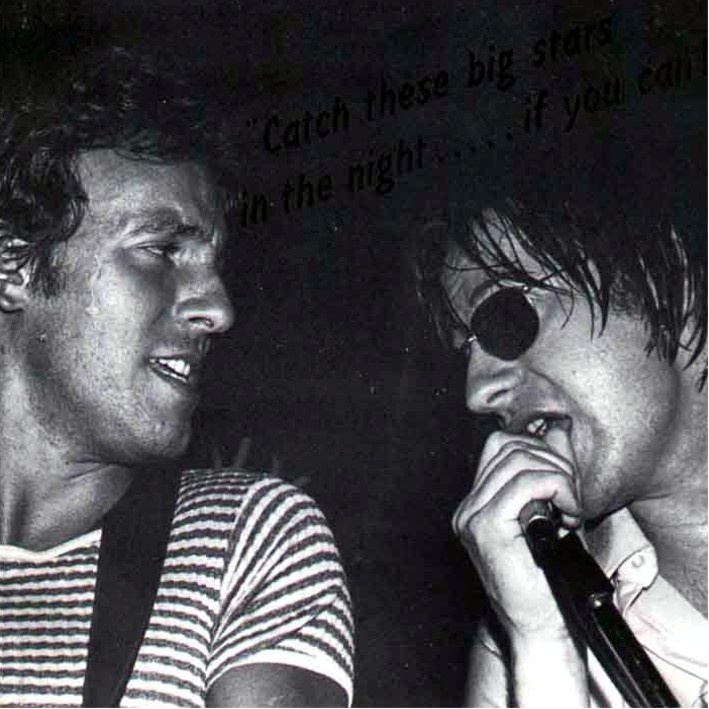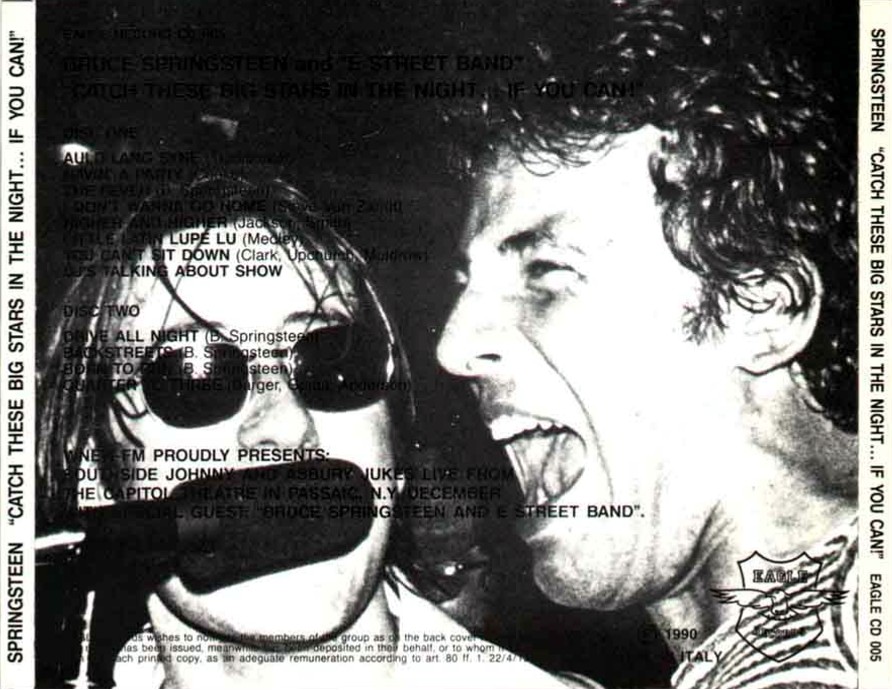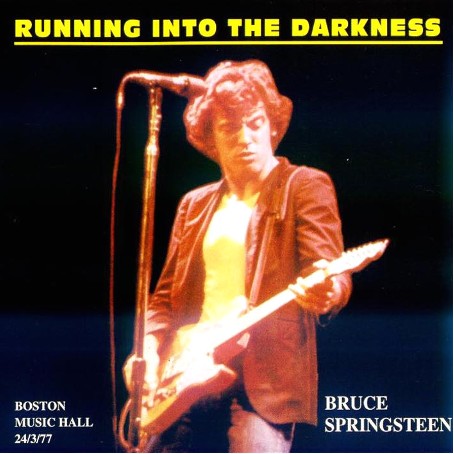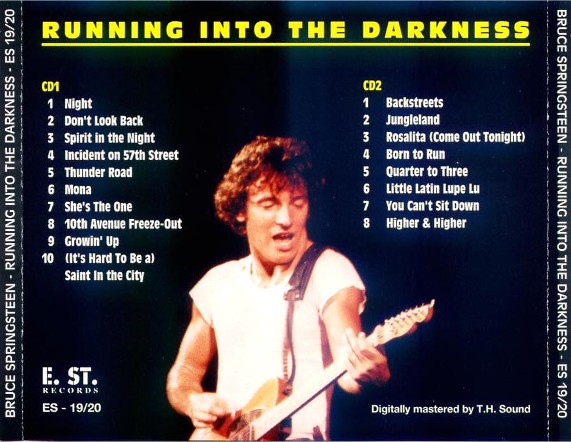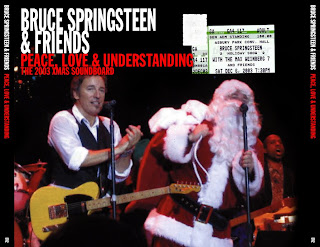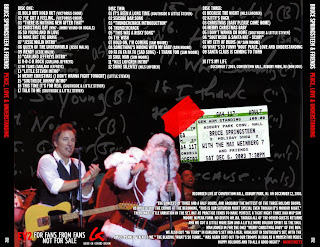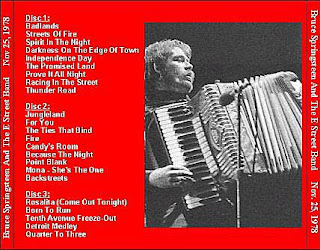L’articolo su Bruce Springsteen di oggi è tratto da un giornale del 1982.
di oggi è tratto da un giornale del 1982.
Buona lettura e buona settimana.
When he switched on his new four-track Tascam cassette recorder in a bed room of his rented Holmdel, N.J. home last January 3, Bruce Springsteen wasn’t trying to make an album, just demos of a batch of songs written since his marathon 19801981 tour of Europe and America had ended the previous September. Springsteen was shortly due to begin rehearsals with the E Street Band before recording the followup to his first number one album, The River. The band would learn the songs from solo demo tapes. So Springsteen didn’t need to worry that the straight-backed wooden chair in which he sat creaked as he swayed and sang. He wasn’t concerned that a couple of the songs repeated lines almost word for word; the Iyrics were always the last item finished, anyway. Most of all, he relaxed as he played. With only roadie Mike Batlin, sitting in as engineer, for an audience, Springsteen let some of his extraordinary self- consciousness slip away. He did not simply toss off the songs; each number was an assured performance. But the performances weren’t calculated or studied. Like an artist sketching, Springsteen used only the simplest implements: acoustic guitar, harmonica, and occasionally, a muted electric guitar, without a reverb or fuzztone. Springsteen then put the Tascam through its paces, adding echo, a bit of synthesizer, doubling his voice in some spots, putting in backing vocals in others.
Over the next few days, listening to the cassette that resulted, Springsteen became more and more fascinated, not only by the songs themselves, but by his performances, too. The songs were as much of a piece as any album he had released, and the singing and playing, for all their starkness, flowed freely and elegantly, creating a mood that was intimate and uninhibited. There was something else, too, an eerie mystery that suggested the cassette had a life and will of its own. In a word, the tape sounded spooky.
Springsteen went into rehearsals, and then the recording sessions, determined not to lose this quality. But such unworldly moments aren’t simply repeated on command. Though the E Street Band made very good versions of some of the songs, none satisfied Bruce. The other songs he’d written were turning out fabulously but the cassette resisted.
Through the spring, Springsteen fought with those songs. For technical reasons, the cassette would be difficult to master as an alhum but he was being pulled towards doing the songs solo, nevertheless. Desperate, he even tried recording them over again, on his own but in the Power Station. Eventually, he and engineer Chuck Plotkin simply determined that they would sweatout whatever it took to master the original cassette. Over the course of a couple of months, both Springsteen and Plotkin lost a lot of sleep and wore their nerves to a frazzle, but in a way, that just made the process seem more real, sister to the famous struggles that had resulted in Springsteen’s other albums. At any rate, by early August, they’d won, with a master disc that kept the sound of the cassette and steadied the stylus in the grooves, as well. Called it Nebraska.
That’s one story you can tell about this record; there’s another version of the events leading up to the creation of Nebraska that begs to he recounted. however.
In October, 1980, when The River was released and his last tour be gan, Bruce Springsteen played to an enormous cult audience. This audi ence believed intensely in the trans formative powers of a Springsteen performance; as a result, through previous tours a compact grew up between Bruce and his listeners. Ht would give them epic sagas of rock and roll grandeur, replete with power and glory, joy and despair, endless struggle and instant party. They would grant him complete attentiveness, and a virtually insatiable desire for more, pushing not greedily so much as reflexively, keeping the faith the songs expressed, surfing the waves of the music. “The amount of freedom that I get from the crowd is really a lot,” said Springsteen, after a month on the road. He was especially fond of what he referred to as “the big silence,” the contemplative stillness which greeted his quieter, more reflective pieces. A month later, with “Hungry Heart” well on its way to becoming his first top ten single, Springsteen faced a far different audience, no less enthusiastic but a great deal more casual about his shows. This was fitting and necessary; the ritualized cultism, by itself, was a dead end for an artist with Springsteen’s broad ambition. And when it came to rocking out, the new audiences were amazing, quickly caught up in the rapturous E Street environment.
Nevertheless, the newer and larger audience diluted the depth of the rapport, which was especially noticeable in the restlessness with which Springsteen’s slower, quieter songs were greeted. Caught in the exhilaration of the situation, nobody was complaining, though a few observers grew wary of whether even Springsteen could control this massive audience.
In the spring of ’81, Springsteen and the band began their first fullscale European tour. Bruce was greeted as a rock ‘n’ roll emissary whose mission was nothing less than the dissemination of the American dream, and he was given all the respect and devotion that went with it.
Early in each evening’s show, Springsteen would request that the audience maintain silence during the softer passages of the show. The result was as stunning as anything I have ever seen in fifteen years of writing about music. When Springsteen offered a spoken introduction, sang a ballad or the nightly version of “This Land Is Your Land,” the crowd became dead still. But this silence had a special quality—it was vibrant, electric and intense, broken, if at all, only by the soft murmur of friends who spoke English offering quick translations for others nearby. On especially good nights, I felt I could hear people listening. Their deep concentration hung tangibly in the air, and when Springsteen roared back into a rocker like “Badlands,” the mood broke like a superb wave. Bruce rode it that way.
Meanwhile, back in the States, Springsteen’s audience grew even younger and less sensitive to any kind of exchange with the star. It became more and more evident that Springsteen’s listeners were beginning to hem him in, as every superstar’s audience has hemmed him in. Reviewers mentioned this, wondering about how Springsteen would cope; long-time fans grew disgruntled as the newcomers stomped and clapped through “Independence Day” and “Point Blank,” ostensibly in tribute but really asserting their impatience to get on with the rocking.
I don’t know if this decreasing sense of rapport frustrated Bruce; it would be amazing if it hadn’t disturbed him somehow. In any case, it seems certain that if he had released another hard rock record as the sequel to The River, that newer, more casual audience might have buried any possibility of regaining the special relationship
his best concerts created. Those concerts were genuinely two-way affairs, as all great rock shows must be; the new audiences weren’t passive—they demanded entertainment—but they weren’t willing to work, either.
At the very least, Nebraska will tax the attention of such listeners. While I doubt that this had much to do with why Bruce Springsteen made this album, reclaiming that rapport with his listeners is one of Nebraska’s most important functions. But there’s another reason to tell this tale. In some of Nebraska’s best songs—”Used Cars,” “Highway Patrolman,” “Mansion on the Hill”—Springsteen recaptures the hushed intimacy of those European concerts. Indeed, from time to time, these songs seem to have blossomed from the echoes of those vibrant silences.
Ten years ago, when Bruce Springsteen made his first album, Columbia Records and his manager-producer, Mike Appel, tried to force him into a mold: Springsteen was to be “the new Dylan,” the apotheosis of the singer-songwriter. A largely acoustic solo set was what Appel and Columbia’s John Hammond wanted and expected. So it’s tempting to say with the largely acoustic, solo Nebraska, Bruce has finally made his “Dylan” album.
But this isn’t singer-songwriter music, any more than it is rock ‘n’ roll. Nor is it folk music, despite the acoustic instrumentation. The chords and melodies from which Springsteen builds his songs are pop and rock rudiments. It’s the coloration and phrasing that have changed. In the way his guitar playing sometimes suggests a mandolin or his vocals recall Jimmie Rodgers’ yodelling or the cadences of white gospel singers, Springsteen, rock’s greatest synthesist of traditions, hints at an ability to incorporate for the first time in his music, genres older than rock ‘n’ roll and rhythm ‘n’ blues. All of his resources, however, remain rooted in specifically American styles; this provides an undeniable link to Dylan’s best work, but that doesn’t make Nebraska neo-Dylan, unless you’d say that of Willie and The Poor Boys, too.
Dylan’s influence can be heard here, especially in the extended, sighing “all” which links the last line of “Used Cars” to Dylan’s first great song, ”Song to Woody.” That’s fitting, for if Dylan is the father of such a musical approach, its grandfathers are Woody Guthrie and Hank Williams. Nor does it take an expert with a road map to trace the impact of this lineage on Nebraska. But rooting about for antecedents gets you only so &r, for more than anything Nebraska is Bruce Springsteen himself, speaking more directly and more personally than ever before.
Once you’re past the shock of hearing Springsteen play and sing with such stark assurance, Nebraska clearly works familiar territory. It has the cars, the highways, the guilt and quest for redemption and most importantly, many of the same characters of Springgteen’s other work. Joe Roberts, the protagonist of “Highway Patrolman,” is a more mature relation of the men in “Racing in the Street,” “The River” and “Born to Run.” The nameless narrator of “Atlantic City” might be reliving “Meeting Across the River,” and the anonymous wild man of “State Trooper” and “Open All Night” is virtually indistinguishable from the hopeless romantics of “Stolen Car” and “Ramrod.” And who is Mary Lou but the girl whose dress waves early in “Thunder Road”? Isn’t the dreamer of “My Father’s House” the man whose other nightmares are recounted in “Darkness on the Edge of Town” and “Wreck on the Highway”?
But there is someone missing from the cast, or rather, someone who is almost
unrecognizable here: the exuberantly hopeful singer of “Badlands” and “The Promised Land,” “Hungry Heart” and “Thunder Road.” If that man is here, his presence is stunted and twisted, stripped of the desperate joy that is fundamental to his earlier incarnations.
This measures the degree to which Springsteen’s world has changed. Springsteen’s first two rock ‘n’ roll albums opened with proclamations of vitality: “It ain’t no sin to be glad you’re alive” (“Badlands”); “This is a town full of losers, I’m pullin’ outta here to win” (“Thunder Road”). In two of the first four songs on Nebraska, men virtually beg to be executed. And in this album’s most heartbreaking moment, the protagonist of “Used Cars,” a decent kid embittered by poverty, sings of a town full of losers in which no one has even the hope of pulling away: “My dad sweats the same job from mornin’ to morn/Me, I walk home on the same dirty streets where I was born.”
In this world, someone like the highway patrolman Joe Roberts, the most beautifully drawn character Springsteen has ever created, may obey his most decent instincts and still find that he has betrayed himself. In this world, there are “debts no honest man could pay”— owed not by one man, but by many men. There is not just the scarcity of work found in The River; “they closed down the auto plant in Mahway,” and it stays shut. Bosses run wild over workers, and while one class hides behind “gates of hardened steel,” the other works the night shift for punishment. In this land, it is no wonder that men can become as twisted as those in “Johnny 99,” “Atlantic City” and most of all, “Nebraska.”
The tragedy is that this world is recognizable; it is the land we now live in, the society being created by Reaganism and neo-conservatism. Nebraska is the first album by an American performer to come to terms with this political and emotional climate, in which mass murderer Charles Starkweather’s “meanness in the world” is unleashed and made a central tenet of the way human beings are expected to deal with one another.
In this climate, people go mad— not only crazy, but vicious. Nothing remains to check their casual cruelty, and even someone like Joe Roberts, a stolid center of gravity, can’t keep his world from falling apart. In the face of this mean reality, hope, faith, the possibility of redemption—the very engines that have always propelled Springsteen’s music—seem nothing less than absurd. In “Atlantic City,” the singer toys with the idea of reincarnation, as a signal that he’ll soon be able to test its truth; in “Reason to Believe,” the album’s final song, the idea of a life after death is seen as no more ridiculous than the idea that people will treat one another with decency in this one.
In his European shows, Springsteen would sometimes sing an Elvis Presley song. He chose “Follow That Dream,” writing a new verse which expressed his faith in the American possibility Elvis personified: Now every man has the right to live, The right to a chance to give what he has to give, The right to fight for the things he believes
For the things that come to him in dreams
In many ways, Springsteen’s life and career can be seen as an acting out of those lines, an unswerving attempt to put that faith into action. In Nebraska’s final two songs, “My Father’s House” and “Reason to Believe,”
Springsteen finally confronts the possibility that his faith will never be effective, that his idealism is in fact a view of the world turned upside down. “My Father’s House,” a song which moves with the ancient cadences of myth, is as fully realized as any song Springsteen has ever written. But its dream of reconciliation between father and son is ultimately hollow, and while this dream (which incorporates psychological, political and religious symbols) continues to beckon, at the end, he just acknowledges that “our sins lie unatoned,” something that not only has never occurred in Springsteen’s other work, but isn’t even conceivable in most of it.
Cast so far from grace, the very fact that men bother to rise from their beds comes to seem wondrous and bizarre. “Reason to Believe,” on which the album closes, is far from the upbeat, optimistic ending a supericial glimpse might suggest. Indeed, its title is a macabre joke, since the song is really a series of situations in which belief is all but impossiblc- situations in which believing may finally be inconsequential. And while Springsteen brings himself to accept that men (including himself, he hints) do believe, he is unable to fathom why.
The quandary in which this leaves Springsteen isn’t strictly personal. Nebraska is an album which speaks to a broad section of his audience not only through its images of unemployment and economic despair, but through the vehicle of radical doubt itself. However accidentally constructed, its parts are integrated in such an invigorating and complex way that it has the ability of important works to seize an entire historical moment. If all Bruce Springsteen had done in this album was “grow up” enough to question the remainder of his innocence, that would be an achievement, since most artists never get that far. But in asking such questions, he forces them upon his listeners, too.
There’s no way of knowing how many will hear what Nebraska has to say. One of the functions of the political climate now being created is to sap people of their energy to respond, and since Springsteen is also wrestling with the preconceptions of his audience and, inevitably, the deathlock conservatism of the marketplace, the odds aren’t exactly stacked in his favor. The tragedy is that too many—fans, deejays, critics—may not recall how to respond, may already have surrendered to the erosion of possibility and hope that Nebraska so eloquently depicts.
But as grim as it is, Nebraska suggests to me a kind of hope. If, in our dark, heartless land, there is room for work this personal and challenging, then the battles are still being fought. And while that may be an insufficient respopse, it is one hell of a significant start.
Yet Nebraska continues to seem spooky, not only because it is invested with musical magic, but also because these songs are inhabited by the ghost of a time when we knew very well how to respond. The most imposing question is whether the spirit represented by those ghosts can be made manifest once more. Toward that end, too, Nebraska is a start.



